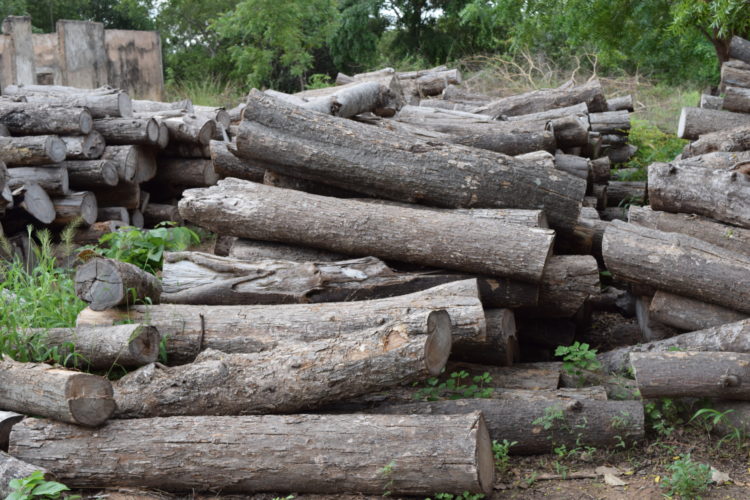During 2020, Mtandao wa Jamii wa Usimamizi wa Misitu Tanzania (MJUMITA) project assisted Mtanzasoma Village (Rufiji District) to defend its forest management rights by providing training to 10 village and network leaders (2 women and 8 men) about the implications of GN 417 of 2019, on their VLFR trade. The training informed them about shift of power of approval of harvesters of timber trees in the VLFRs from Village Council to District Harvesting Committee (DHC) for Forest Produce. Also, the training informed them about their legal position to control decision of DHC, by making sure that, the committee only endorse traders who are approved by the village council. The training was a follow up to the irregularities reported in 2019, where Mtanzamsona Village Forest Patrol Team, confiscated 392 logs with 90m3 of merchantable wood, harvested illegally. The illegality is said to have rooted from the issuance of harvesting permit by TFS in unreserved areas in the nearby village, where there were insufficient trees with Minimum Legal Harvesting Diameter (MLHD. This compelled the loggers to encroach to the VLFR where there were large and highly valuable trees. Auctioning of the logs was characterized by a coordinated disqualification of the highest bidder in favour of the original owner of the logs (the illegal harvester). To disqualify other bidders, the auction announcement provided the condition that the trader/buyer must be a registered timber trader at Mtanzasona village. The auction was publicized only for a day and was not circulated outside the village. The highest buyer bidded for 600,000 TZS per cubic meter of merchantable wood, but lower bidder (470,000/= TZS) was surprisingly favoured. The village raised TZS 42.3 million instead of TZS 54 million and hence lost TZS 11.7 million.
Also, during the training, the project team helped them to develop action plan for advocating against irregularities which might be associated with implementation of the new government regulations as well as reporting and making follow to PCCB and district council the problems observed in 2019 harvesting and auctioning. As part of implementing the action plan, on 22/7/2020 the Village Council rejected (3 out of 7) applicants who were seeking to harvest in their VLFR, because they were accused of the 2019 irregularities. Interestingly, the DHC meeting held on 13/8/2020 disregarded the decision by the village council and approved all 7 harvesters to harvest in VLFR. To legalize the decision 2 Forest Officers (DFO and DFM) visited the village on 17/8/2020 trying to influence the village council and general assembly to revoke their previous decision and agree with the DHC, a move which was rejected outright by communities. During this meeting, some community members presented their grievances against the decision by DHC meeting through demonstration and posters.
Through the project’s support, on 22nd August 2020, the village sent a team of 3 community leaders to report their grievances to the Regional Administrative Secretary (RAS), Regional natural Resource Officer (RNRO), District Commissioner (DC), District Executive Director (DED), PCCB, DFO and District Conservator, who promised to take action. Also, on 24th August 2020, another team of 6 community leaders conducted a dialogue with Rufiji DC, DFO and District Conservator and come into resolution that the decision by the village council about rejecting unqualified traders who are also accused of illegal forest trade will prevail. However, the project’s monitoring activities reveal that communities are still in opinion that, the district is still not willing to reject those traders. Moreover, the previous corruption accusations associated with auctioning 116m3 of merchantable wood are still pending at PCCB, but the project is aware that DED and DC for Rufiji are also following up. MJUMITA is also monitoring and supporting communities to make follow up until the case reach an end.
The initiative is contributing to sustainable Management of 9,544 hectares of forest and woodland owned by 479 households, with 1,867 communities, including 1,087 women and 780 men, and has potential of generating at least $ 321,4691 annually for the community. The forest is critical for biodiversity as it is buffering the eastern part of Selous Game Reserve (a World Heritage Site) and a state-owned forest reserve. The forest is also rich of riverine patches and it contributes to the conservation of the Rufiji River ecosystem which supports the livelihoods of surrounding communities, including downstream inhabitants in Rufiji delta as well as the nation at large.
Read more about why Mkuruti is in the verge of disappearing in Rufiji here:
https://www.ippmedia.com/en/features/why-mkuruti-verge-disappearing-rufiji-part-1-0
Based on analysis of Village Forest Harvesting plan for timber trees


Comments are closed, but trackbacks and pingbacks are open.